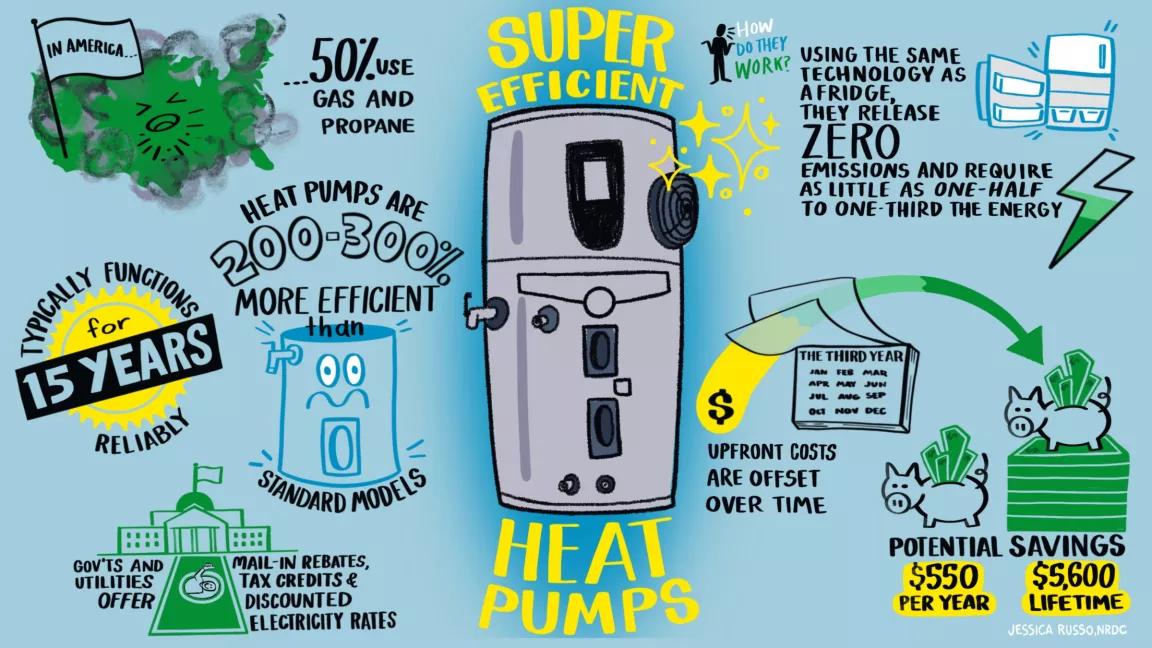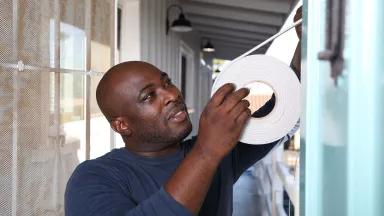What’s the Most Energy-Efficient Water Heater?
The new generation of eco-friendly heat pump water heaters will reduce your home’s emissions while also shrinking your utility bills.
Of all the appliances that compete for a homeowner’s attention, from vacuum cleaner robots to video-enabled door locks that double as security guards, the standard 50-gallon water heater is the most likely to be ignored. Hidden from view in the basement or a dark utility closet, the tall metal cylinder that heats water for our sinks and showers typically functions reliably for a decade or more with little or no maintenance.
But the day will come when that trusted water heater springs a leak and shuts down permanently—prompting an urgent call to the plumber. And it’s best not to wait that long. The technological advances and increasing energy efficiency found in the new generation of environmentally friendly heat pump water heaters (HPWH) make them a worthy investment for anyone looking to reduce both carbon emissions and utility bills at once. HPWHs, which produce heat using the same technology that refrigerators employ to stay cold, release no direct emissions and get the job done on as little as one-half to a third of the energy of a conventional electric resistance or gas water heater.
In other words, HPWHs use much less energy to provide the same level of service. Here’s all you need to know to make the switch.
How a heat pump water heater saves energy
Currently, water heaters of all types account for about 18 percent of U.S. households’ energy consumption—more than cooking and refrigeration combined. Many homes are equipped with electric resistance heaters that needlessly draw excessive amounts of energy from the national power grid and contribute to high utility bills. The impact of gas and propane water heaters, now operating in half of all U.S. homes, is even worse: They burn fossil fuels, releasing greenhouse gases and dangerous toxins like nitrogen oxides, which have been linked to numerous respiratory diseases.
In contrast to conventional gas-fired heaters, which generate heat from pollution-spewing combustion, or electric heaters, which use the same type of inefficient mechanism found in a toaster, HPWHs use an energy-efficient compressor that gathers heat from the atmosphere and concentrates it in a water storage tank. The result: savings for the average four-person U.S. household of $550 a year on electricity bills, or more than $5,600 over the life of a typical HPWH, according to the Energy Star consumer website. (Actual savings will vary, depending on home size, location, and the municipal or private utility that supplies electricity to your home.)
Residential energy efficiency is an important tool in addressing climate change, and embracing greener technologies like this one is a meaningful contribution for the homeowner looking to help propel a low-carbon economy forward.
Teasing out the costs
Updating your water heater is easy and highly cost-effective in the long run. Of the several types of HPWHs now available from respected brands like A.O. Smith, Bradford White, and Rheem, the models marketed as hybrids are the most popular. In addition to compressors that warm water by trapping heat from the environment, they’re equipped with auxiliary immersion heating units. These components are set to activate automatically during periods of high demand, offering reassurance that the hot water won’t run out, even when the house is full of guests. It’s true that the initial cost of investing in new HPWH technology (from $1,100 before incentives) is higher than what you’d expect to pay for a conventional water heater (from $300). But that additional cost will be more than offset by savings accrued over the lifetime of the appliance—in some cases, within just two to three years.
The Inflation Reduction Act’s federal tax credits make the HPWH an even sweeter deal. Specifically, the Energy Efficient Home Improvement [Tax] Credit will refund you up to $2,000 per year for these appliances (among other carbon-saving equipment), whether you’re a homeowner or a renter. These funds will be returned to you when you file your federal taxes. And by early 2024, there will be additional incentives from the federal government to electrify water heating and other home equipment, offering rebates of up to $1,750 for low- and moderate-income homeowners to install HPWHs. Some state and local governments and utility companies also offer mail-in rebates at the time of purchase ($1,000 from both New York’s Con Edison and Southern California Edison, for example).
How to choose the right model
Unless you’re a skilled plumber (and possess the permit required by many municipalities), you’ll probably need to rely on a licensed contractor to buy and install a new heater. Plan to speak to several plumbers in your area to identify those who have experience with HPWHs. Since they currently account for just 1 percent of the water heating market, HPWHs will be unfamiliar territory to many contractors, who may even try to steer you away from energy-efficient options simply because they are more familiar with standard heaters. A qualified professional can also advise you on the right appliance to buy for your home; many municipal utilities list local qualified contractors on their websites.
As a rule of thumb, you may want to choose a heater with a water tank that is larger than the one typically recommended for the size of your household, which will help you to avoid using the hybrid unit’s less-efficient high-demand auxiliary feature. A larger tank that fills with hot water overnight, for instance, will prevent a shortage during bathroom rush hour the next morning. Considering the long-term value of an HPWH, going bigger is worth the additional cost. Water heaters with smart thermostats that initiate heating during off-peak hours (when there is less demand for electricity use) have the added benefit of allowing you to take advantage of clean energy at a lower cost, while still delivering plenty of hot water when you need it most. They essentially act as “batteries” for storing clean energy.
Evolving technology: The space heater that also does air-conditioning
In addition to heating water, heat pump technology can also be used to heat and cool air as an energy-efficient alternative to standard air conditioners (ACs) and furnaces. Just like HPWHs, heat pump space heaters simply move heat from a cool space to a warm space instead of burning fuel to generate heat, thereby reducing emissions and lowering your utility bill. One of the biggest advantages to owning a heat pump is that it’s a two-in-one system—you get both heating and cooling for the price of one.
Right now, only 16 percent of homes in the United States use heat pumps for space heating and cooling. It is the job of policymakers to provide the right incentives to help consumers and installers get more familiar with and excited about these advanced, healthy, climate-friendly technologies. If this technology became the standard for people installing new ACs within the next three years, we could see them in every home by 2050.
This story was originally published on December 11, 2020 and has been updated with new information and links.
This NRDC.org story is available for online republication by news media outlets or nonprofits under these conditions: The writer(s) must be credited with a byline; you must note prominently that the story was originally published by NRDC.org and link to the original; the story cannot be edited (beyond simple things such as grammar); you can’t resell the story in any form or grant republishing rights to other outlets; you can’t republish our material wholesale or automatically—you need to select stories individually; you can’t republish the photos or graphics on our site without specific permission; you should drop us a note to let us know when you’ve used one of our stories.





What Are the Solutions to Climate Change?
How to Ditch the Biggest Fossil Fuel Offenders in Your Life
How You Can Stop Global Warming